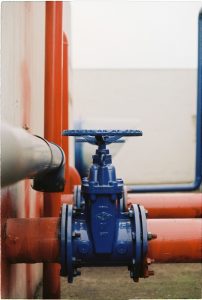La valvola a quattro vie è un semplice dispositivo per controllare il flusso del fluido in un sistema. Queste valvole sono del tipo a spola, con il vantaggio di avere uguali superfici per la pompa e per il serbatoio. Hanno anche una simmetria verticale, che li rende una scelta ideale per applicazioni che richiedono il controllo di un flusso di fluido.
Una valvola a quattro vie ha quattro porte attorno alla sua camera. Il tappo del rubinetto della valvola ha due passaggi che collegano le porte adiacenti. Può essere cilindrico, affusolato o sferico.
Ogni porta ha due posizioni di flusso e il tappo è normalmente posizionato centralmente. Inoltre, quando la valvola è in posizione chiusa, le porte di ingresso e di scarico rimangono entrambe aperte.
Se vuoi saperne di più su una valvola a 4 vie e su come funziona, continua a leggere questo articolo.
Indice dei contenuti
ToggleCos'è una valvola a quattro vie?
When you see a 4-way valve, it looks like a simple directional control valve. However, it is often used in double-acting cylinder applications. This type of valve has 4 ports and two flow positions. These valves always supply pressure to one side of the cylinder while allowing the opposite side of the cylinder to be emptied into the atmosphere. As a result, they are very common in double-acting cylinders. The name comes from the four positions the valve can accommodate.
Queste valvole sono utili per il posizionamento sequenziale perché sono in grado di cambiare direzione senza perdere il segnale. Una valvola a quattro vie è più adatta per applicazioni in cui la pressione cambia nel tempo ed è anche utile per il trattamento chimico della piscina e la rigenerazione dell'addolcitore dell'acqua.
Queste valvole furono utilizzate per la prima volta nei primi motori a vapore a doppio effetto. La valvola a quattro vie è costituita da due passaggi a forma di "L" che non si interconnettono, uno su ciascun lato della spina. I due passaggi a forma di "L" nella spina non sono collegati, rendendo difficile identificare una valvola a quattro vie in un ambiente sconosciuto.
Il meccanismo di lavoro di una valvola a quattro vie
In un primo motore a vapore a doppio effetto, veniva utilizzata una valvola a quattro vie per controllare il flusso di vapore al cilindro. Il meccanismo di funzionamento di una valvola a quattro vie prevede due passaggi "a forma di L" che non si interconnettono. Inoltre, una valvola a 4 vie è anche nota come "porta x".
Nelle applicazioni con attuatori, una valvola a quattro vie può essere lasciata nella posizione di blocco. In questo caso la valvola trasferisce la pressione idraulica dal collettore alla porta chiusa del cilindro e la stessa pressione ritorna al serbatoio di riserva. Una valvola a quattro vie può essere lasciata nella posizione di blocco quando il rig viene spostato o si sta riparando da solo.
La valvola a quattro vie ha quattro porte. La valvola ha una funzione universale, che le permette di funzionare sia come deviatore che come regolatore. Questo tipo di valvola ha due posizioni di flusso. Quando la valvola è in posizione centrale, è chiusa. Ci sono un totale di quattro o cinque tubi collegati a questa valvola. È possibile chiudere completamente la valvola, aprirla completamente o aprirla parzialmente.
Quando lo si sposta nella posizione opposta alla posizione centrale, la valvola è completamente aperta. Tuttavia, quando si sposta la maniglia a metà, è parzialmente aperta. Con queste valvole è possibile invertire facilmente il moto di un cilindro o di un motore.
Advantages of a 4-Way Valve
Versatilità
Four-way valves are versatile components that provide multiple flow path options, allowing engineers to control the direction of fluid flow in hydraulic or pneumatic systems.
The versatility of 4-way valves is particularly beneficial in applications where the direction of fluid flow needs to be changed regularly.
These valves feature four ports, enabling the redirection of fluid to different paths within the system.
This flexibility is invaluable for dynamic systems requiring adaptable flow control.
Efficient Control
These valves offer precise control over hydraulic or pneumatic systems, facilitating the accurate management of fluid flow and system components.
The ability to direct fluid to different outlets or paths enables efficient control of actuators, cylinders, or other components within the system.
This precision is crucial for applications that require accurate and controlled movements, such as robotics, manufacturing equipment, or other automated systems.
Simplifies System Design
Integrating multiple functions into a single 4-way valve simplifies system design, potentially leading to cost savings and a more compact layout.
Instead of using multiple valves for different functions, a single 4-way valve can handle various tasks.
This streamlined design not only reduces the number of components in the system but also simplifies the overall architecture.
The consolidation of functions enhances system efficiency and can contribute to a more straightforward installation and maintenance process.
Disadvantages of a 4-Way Valve
Complexity
The added functionality of 4-way valves may result in increased complexity, demanding careful consideration during system design.
Engineers need to understand the internal design, electrical or pneumatic controls, and potential interdependencies of 4-way valves.
The complexity may involve aspects such as the valve’s switching mechanism, feedback systems, and compatibility with other system components.
Proper engineering and documentation are crucial to manage and troubleshoot the complexity effectively.
Costo
Four-way valves can be more expensive than simpler alternatives, and the overall cost may vary based on various factors.
The initial investment in 4-way valves may be higher due to their advanced features and capabilities.
Factors influencing the cost include the valve size, materials used in construction, and the level of automation or control features.
While the upfront cost may be a consideration, it’s essential to weigh the long-term benefits in terms of system efficiency, reduced components, and potential operational cost savings.
Maintenance Challenges
The increased complexity of 4-way valves may lead to more intricate maintenance procedures, requiring careful planning.
Maintenance involves understanding the valve’s internal components, seals, and potential failure modes.
Regular inspections and preventative maintenance are essential to ensure continued reliable performance.
Any downtime for maintenance should be carefully planned to minimize disruptions to the overall system.
Proper training for maintenance personnel is crucial to address the intricacies of 4-way valve maintenance effectively.
What is the Difference Between a 3-Way Valve and a 4-Way Valve?
A 3-way valve has three ports: one inlet and two outlets (or vice versa). It is commonly used for diverting or mixing flows in various applications.
On the other hand, a 4-way valve has four ports and is often employed in more complex systems where the flow needs to be diverted or switched between different paths.
The additional port in a 4-way valve offers more versatile control options, making it suitable for diverse hydraulic or pneumatic systems.
Chiave da asporto
While 4-way valves offer significant advantages in terms of versatility, control, and simplified system design, careful consideration of their complexity, cost, and maintenance requirements is essential for successful integration into hydraulic or pneumatic systems.
Engineers must balance these factors to optimize the performance and efficiency of their systems over the long term.










